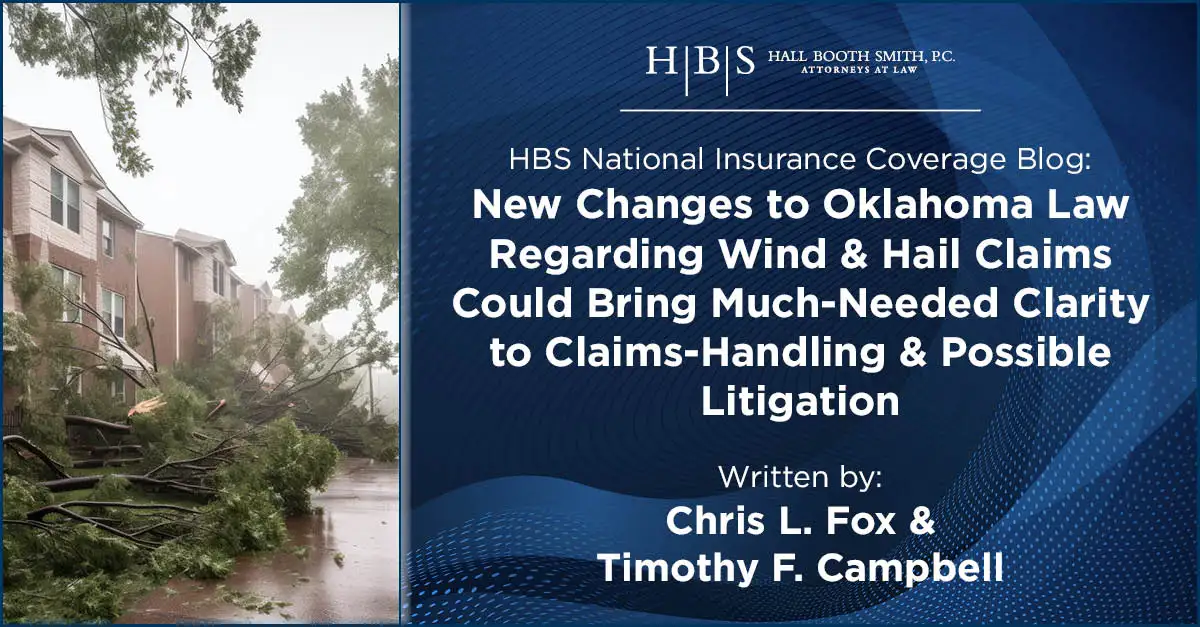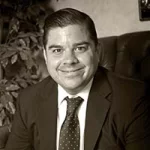
New Changes to Oklahoma Law Regarding Wind & Hail Claims Could Bring Much-Needed Clarity to Claims-Handling & Possible Litigation

As Oscar Hammerstein famously noted, Oklahoma is “where the wind comes sweepin’ down the plain.” Along with it typically comes damage to roofs caused by wind and hail. Following not far behind like storm clouds on the horizon are disputes over claims-handling and, often, litigation.
Background
Oklahomans are no strangers to severe weather. According to the National Oceanic and Atmospheric Administration, Oklahoma saw a total of 518 severe weather events in 2022, comprised of 28 tornadoes, 214 hail storms, and 276 strong wind events. One major carrier ranked Oklahoma among the top 10 states for hail claims in 2022 and reported paying a whopping $126 million in hail-related claims.
Severe weather events are anticipated to increase across the nation as the effects of climate change make such events more common, according to a new report by the American Meteorological Society. In light of the anticipated up-tick in severe weather events, state legislatures across the country — including the Oklahoma Legislature — are taking steps to reshape the coverage and claims-handling landscape.
During the 2022 legislative session, the Oklahoma Legislature amended the Unfair Claims Settlement Practices Act (UCSPA), 36 O.S. § 1250.5(7) to include the underlined language:
Except where there is a time limit specified in the policy, making statements, written or otherwise, which require a claimant to give written notice of loss or proof of loss within a specified time limit and which seek to relieve the company of its obligations if the time limit is not complied with unless the failure to comply with the time limit prejudices the rights of an insurer.
Any policy that specified a time limit covering damage to a roof due to wind or hail must allow the filing of claims after the first anniversary but no later than twenty-four (24) months after the date of loss, if the damage is not evident without inspection.1
Amendment Review
The primary purpose of this amendment appears to be to place a firm deadline of two years in which wind and hail claims must be reported. Under prior practice, it was not uncommon for property owners to submit such claims long after the two-year window now provided by law. This would most often occur when a property owner set out to sell a home or other structure and a subsequent inspection identified roof damage.
If such damage was discovered in the course of a sale-related inspection, buyers would often stipulate the seller submit a claim and obtain a new roof prior to consummating the sale. Overall, the inclusion of a one-year floor and two-year ceiling on wind and hail claim reporting should provide some much-needed clarity with respect to the parties’ respective rights and obligations.
Although there have yet to be any reported cases interpreting the new language in the UCSPA, it is likely litigation over its application will arise soon once it is invoked to support denial of untimely-reported claims. Further, the question of whether the damage at issue “is not evident without inspection” seems particularly fertile soil for dispute, requiring eventual judicial resolution.
Finally, insureds and insurers will surely also clash over when, exactly, the date of loss occurred, or what exactly constitutes “filing of claims” under this section.
Oklahoma has long acknowledged a cause of action in tort for breach of the implied duty of good faith and fair dealing by insurers with respect to their insureds.2 A successful litigant can obtain punitive damages in addition to recovery of the typical array of contractual damages.Those cases require “a clear showing that the insurer unreasonably, and in bad faith, with[held] payment of the claim of its insured.”3
Subsequent case law set forth the elements of a bad faith claim in Oklahoma as follows: (1) the claimant was entitled to coverage under the insurance policy at issue; (2) the insurer had no reasonable basis for delaying the payment; (3) the insurer did not deal fairly and in good faith with the claimant; and (4) the insurer’s violation of its duty of good faith and fair dealing was the direct cause of the claimant’s injury.4 The absence of any of those four elements is fatal to a bad faith claim.
Bad Faith Guidance
Although the Oklahoma Supreme Court has determined the UCSPA does not provide an insured with a private right of action against his or her insurer for breach thereof, violation of § 1250.5 of the UCSPA, it does provide courts with guidance in determining whether given industry conduct is unreasonable and therefore sufficient to constitute actionable bad faith.
Historically, bad faith claims have arisen from “an insurer’s failure to follow judicial construction of insurance contracts or available applicable law, as well as upon duties that are necessary for an insurer’s timely determination of a claim.”5 However, violation of a duty imposed by 36 O.S. § 1250.5 will not automatically give rise to liability.
To prevail, a plaintiff must show the alleged violation was “committed flagrantly and in conscious disregard of [the UCSPA]” or “has been committed with such frequency as to indicate a general business practice” to engage in conduct violative of the UCSPA.6 Therefore, carriers should be cognizant of insureds’ new obligation to timely report but should also continue to carefully evaluate each claim in light of its particular facts.
Closing
As severe weather events become more common, so, too, will litigation arising from handling of wind and hail claims. The new amendment to 36 O.S. § 1250.5(7) should provide needed clarity regarding the insured’s obligation to report such claims and carriers’ duty to accept and adjust the same.
However, as with all legislation, the precise language of this amendment will inevitably lead to litigation which will have to be resolved via adjudication. Until the courts have had a chance to weigh in, carriers should maintain their current practice of diligently examining the facts and timing of each wind and hail claim to determine whether denial of a claim perceived to be tardy under the new 36 O.S. § 1250.5(7) is warranted.
Footnotes
- The amendment was signed into law on May 22, 2022, and went into effect immediately.
- See Christian v. American Home Assurance Co., 1977 OK 141, ¶ 26, 577 P.2d 899; Badillo v. Mid Century Ins. Co., 2005 OK 48, 121 P.3d 1080.
- Christian, at ¶ 26, at 905.
- Ball v. Wilshire, 2009 OK 38, ¶ 21, 221 P.3d 717, 724.
- Brown v. Patel, 2007 OK 16, ¶ 11, 157 P.3d 117.
- 36 O.S. § 1250.3(B)(1-2).
Disclaimer
This material is provided for informational purposes only. It is not intended to constitute legal advice nor does it create a client-lawyer relationship between Hall Booth Smith, P.C. and any recipient. Recipients should consult with counsel before taking any actions based on the information contained within this material. This material may be considered attorney advertising in some jurisdictions. Prior results do not guarantee a similar outcome.
About the Authors
Oklahoma City Partner Chris L. Fox defends health care providers, insurers, and professionals in a wide range of medical malpractice litigation. He also represents clients in internal investigations, licensing and regulatory matters, and during administrative procedures.

Oklahoma City Associate Timothy F. Campbell focuses his practice on health care, medical malpractice, premises liability, and bad faith defense matters. He has extensive experience in civil litigation and has conducted a number of bench and jury trials, both solo and as second chair.


Leave a comment
You must be logged in to post a comment.